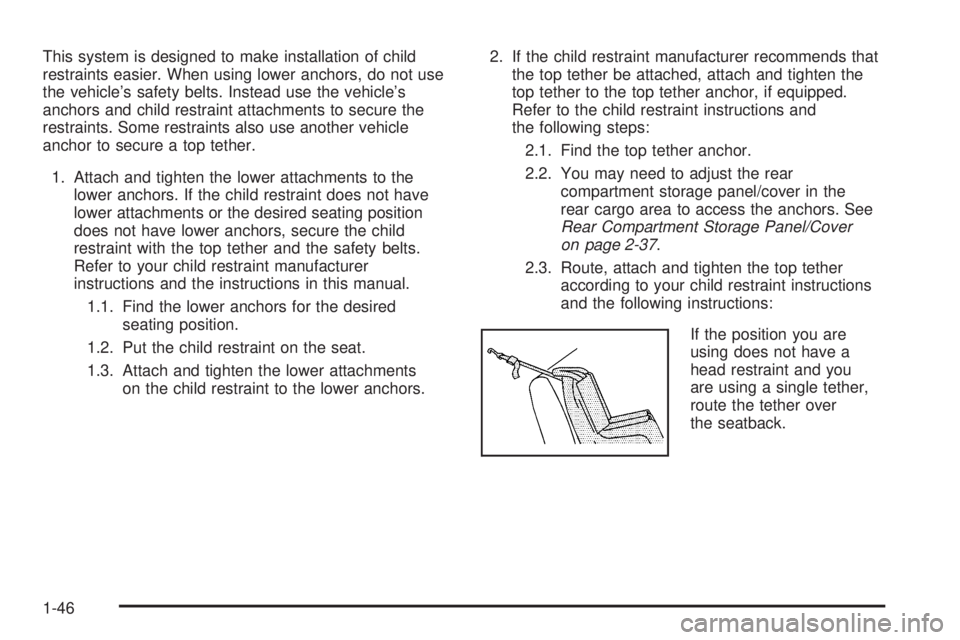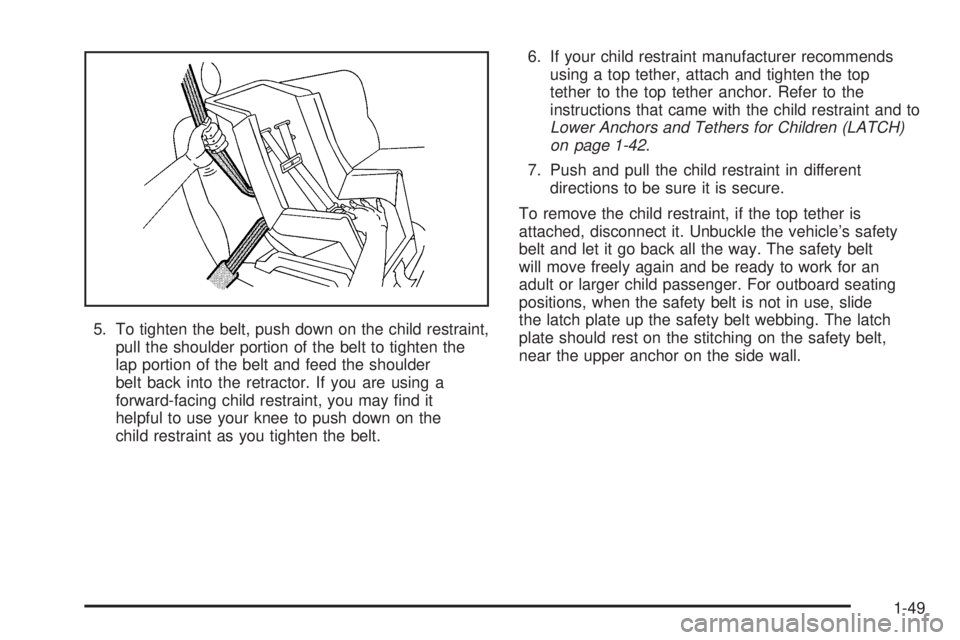Page 50 of 368

Each rear seating position has exposed metal anchors
located in the crease between the seatback and the
seat cushion.
The top tether anchors for each rear seating position are
located on the back of the rear seatback. You may need
to adjust the rear compartment storage panel/cover in
the rear cargo area to access the anchors. Be sure to use
an anchor located on the same side of the vehicle as the
seating position where the child restraint will be placed.Do not secure a child restraint in the right front
passenger’s position if a national or local law requires
that the top tether be attached, or if the instructions
that come with the child restraint say that the top tether
must be attached. There is no place to attach the top
tether in this position.
Accident statistics show that children are safer if they
are restrained in the rear rather than the front seat.
SeeWhere to Put the Restraint on page 1-40for
additional information.
Securing a Child Restraint Designed
for the LATCH System
{CAUTION:
If a LATCH-type child restraint is not attached
to anchors, the restraint will not be able to
protect the child correctly. In a crash, the child
could be seriously injured or killed. Make sure
that a LATCH-type child restraint is properly
installed using the anchors, or use the vehicle’s
safety belts to secure the restraint, following
the instructions that came with that restraint,
and also the instructions in this manual.
1-44
Page 52 of 368

This system is designed to make installation of child
restraints easier. When using lower anchors, do not use
the vehicle’s safety belts. Instead use the vehicle’s
anchors and child restraint attachments to secure the
restraints. Some restraints also use another vehicle
anchor to secure a top tether.
1. Attach and tighten the lower attachments to the
lower anchors. If the child restraint does not have
lower attachments or the desired seating position
does not have lower anchors, secure the child
restraint with the top tether and the safety belts.
Refer to your child restraint manufacturer
instructions and the instructions in this manual.
1.1. Find the lower anchors for the desired
seating position.
1.2. Put the child restraint on the seat.
1.3. Attach and tighten the lower attachments
on the child restraint to the lower anchors.2. If the child restraint manufacturer recommends that
the top tether be attached, attach and tighten the
top tether to the top tether anchor, if equipped.
Refer to the child restraint instructions and
the following steps:
2.1. Find the top tether anchor.
2.2. You may need to adjust the rear
compartment storage panel/cover in the
rear cargo area to access the anchors. See
Rear Compartment Storage Panel/Cover
on page 2-37.
2.3. Route, attach and tighten the top tether
according to your child restraint instructions
and the following instructions:
If the position you are
using does not have a
head restraint and you
are using a single tether,
route the tether over
the seatback.
1-46
Page 53 of 368

If the position you are
using does not have a
head restraint and you
are using a dual tether,
route the tether over
the seatback.
If the position you are
using has an adjustable
head restraint and you
are using a dual tether,
route the tether around
the head restraint.
If the position you are
using has an adjustable
head restraint and you
are using a single tether,
route the tether under
the head restraint and
in between the head
restraint posts.
3. Push and pull the child restraint in different
directions to be sure it is secure.Securing a Child Restraint in a
Rear Seat Position
If your child restraint is equipped with the LATCH
system, seeLower Anchors and Tethers for Children
(LATCH) on page 1-42.
If your child restraint does not have the LATCH system,
you will be using the lap-shoulder belt to secure the
child restraint in this position. Be sure to follow the
instructions that came with the child restraint. Secure
the child in the child restraint when and as the
instructions say.
1. Put the child restraint on the seat.
2. Pick up the latch plate, and run the lap and shoulder
portions of the vehicle’s safety belt through or
around the restraint. The child restraint instructions
will show you how.
1-47
Page 54 of 368
3. Buckle the belt. Make sure the release button is
positioned so you would be able to unbuckle the
safety belt quickly if you ever had to.4. Pull the rest of the shoulder belt all the way out of
the retractor to set the lock.
1-48
Page 55 of 368

5. To tighten the belt, push down on the child restraint,
pull the shoulder portion of the belt to tighten the
lap portion of the belt and feed the shoulder
belt back into the retractor. If you are using a
forward-facing child restraint, you may �nd it
helpful to use your knee to push down on the
child restraint as you tighten the belt.6. If your child restraint manufacturer recommends
using a top tether, attach and tighten the top
tether to the top tether anchor. Refer to the
instructions that came with the child restraint and to
Lower Anchors and Tethers for Children (LATCH)
on page 1-42.
7. Push and pull the child restraint in different
directions to be sure it is secure.
To remove the child restraint, if the top tether is
attached, disconnect it. Unbuckle the vehicle’s safety
belt and let it go back all the way. The safety belt
will move freely again and be ready to work for an
adult or larger child passenger. For outboard seating
positions, when the safety belt is not in use, slide
the latch plate up the safety belt webbing. The latch
plate should rest on the stitching on the safety belt,
near the upper anchor on the side wall.
1-49
Page 57 of 368
A rear seat is a safer place to secure a forward-facing
child restraint. If you need to secure a forward-facing
child restraint in the right front seat, you will be using the
lap-shoulder belt to secure the child restraint in this
position. Be sure to follow the instructions that came with
the child restraint. Secure the child in the child restraint
when and as the instructions say.
1. Because your vehicle has a right front passenger’s
airbag, always move the seat as far back as it will
go before securing a forward-facing child restraint.
SeeManual Seats on page 1-2.
2. Put the child restraint on the seat.
3. Pick up the latch plate, and run the lap and shoulder
portions of the vehicle’s safety belt through or
around the restraint. The child restraint instructions
will show you how.4. Buckle the belt. Make sure the release button is
positioned so you would be able to unbuckle the
safety belt quickly if you ever had to.
1-51
Page 58 of 368
5. Pull the rest of the shoulder belt all the way out of
the retractor to set the lock.6. To tighten the belt, push down on the child restraint,
pull the shoulder portion of the belt to tighten the lap
portion of the belt and feed the shoulder belt back
into the retractor. You may �nd it helpful to use your
knee to push down on the child restraint as you
tighten the belt.
7. Push and pull the child restraint in different
directions to be sure it is secure.
To remove the child restraint, just unbuckle the vehicle’s
safety belt and let it go back all the way. The safety belt
will move freely again and be ready to work for an adult or
larger child passenger. When the safety belt is not in use,
slide the latch plate up the safety belt webbing. The latch
plate should rest on the stitching on the safety belt, near
the guide loop on the side wall.
1-52
Page 60 of 368

Here are the most important things to know about the
airbag system:
{CAUTION:
You can be severely injured or killed in a crash
if you are not wearing your safety belt — even
if you have airbags. Wearing your safety belt
during a crash helps reduce your chance of
hitting things inside the vehicle or being ejected
from it. Airbags are “supplemental restraints”
to the safety belts. All airbags are designed to
work with safety belts but do not replace them.
Frontal airbags for the driver and right front
passenger are designed to deploy in moderate
to severe frontal and near frontal crashes.
They are not designed to in�ate in rollover, rear
crashes, or in many side crashes. And, for some
unrestrained occupants, frontal airbags may
provide less protection in frontal crashes than
more forceful airbags have provided in the past.
CAUTION: (Continued)
CAUTION: (Continued)
Roof-mounted side impact airbags are designed
to in�ate in moderate to severe crashes where
something hits the side of your vehicle. They
are not designed to in�ate in frontal, in rollover
or in rear crashes. Everyone in your vehicle
should wear a safety belt properly — whether
or not there is an airbag for that person.
{CAUTION:
Both frontal and side impact airbags in�ate
with great force, faster than the blink of an
eye. If you are too close to an in�ating airbag,
as you would be if you were leaning forward,
it could seriously injure you. Safety belts help
keep you in position for airbag in�ation before
and during a crash. Always wear your safety
belt even with frontal airbags. The driver
should sit as far back as possible while still
maintaining control of the vehicle. Occupants
should not lean on or sleep against the door.
1-54